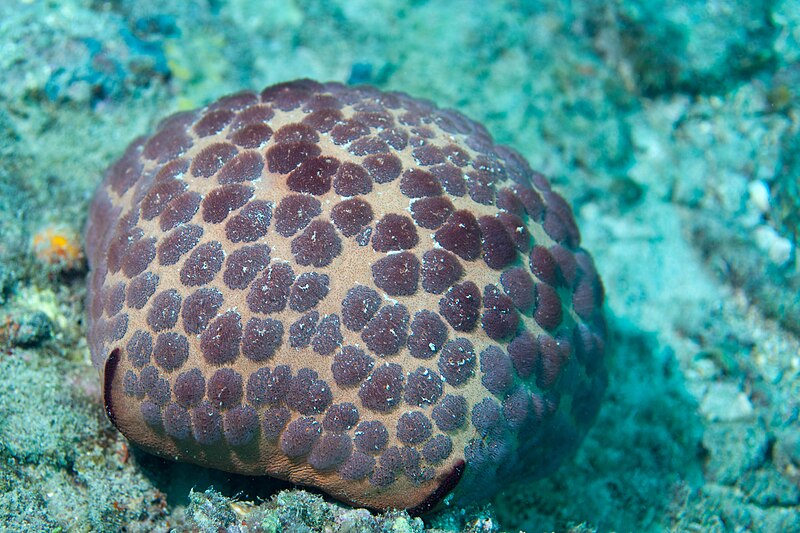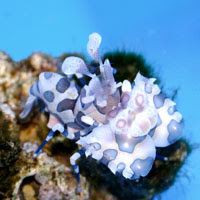Frank Indiviglio here with an introduction to Echinoderms.
Sea stars, or starfishes, are perhaps the most familiar of the Echinoderms (a phylum containing over 7,000 marine species), and many adapt well to aquarium life. Most people are quite surprised to realize that they are active, interesting predators that routinely exhibit a wide variety of behaviors in the aquarium. Many are also useful scavengers, but all are predatory in nature and, depending upon the species, will consume mollusks, coral polyps and other sedentary invertebrates.
Red-knobbed Sea Star, Protoreaster lincki
 When picturing a sea star, many people think of the simple reddish-orange animal so often seen as a dried curio in beachfront shops. However, many are fantastic in appearance and coloration. The Red-knobbed Sea Star, with brick-red dorsal spines set off against a dazzling white background, is a case in point.
When picturing a sea star, many people think of the simple reddish-orange animal so often seen as a dried curio in beachfront shops. However, many are fantastic in appearance and coloration. The Red-knobbed Sea Star, with brick-red dorsal spines set off against a dazzling white background, is a case in point.
Native to the Indo-Pacific region, this perennial aquarium favorite reaches a length of 12 inches and is capable of consuming quite large mollusks. It is best fed by placing a piece of clam, scallop or mussel directly below the body, although it is quite active and capable of finding food on its own.
Although sea stars are quite adept at sensing and locating food, they respond more slowly than do most fish. Therefore, they will usually remain hungry in a mixed-species tank unless care is taken to see that food is placed directly below each animal.
Brittle Stars
 Brittle stars bring the word “bizarre” to mind instantly, even to those well acquainted with the sea’s curiosities. They react very quickly to the scent of food, and their long, slender arms thrash wildly about as they begin to explore. It is quite a sight to see a tank housing several of these normally sessile creatures suddenly come to life – the many sinuous arms seem to take on a life of their own, yet the animals glide unerringly toward the source of the odor that aroused them.
Brittle stars bring the word “bizarre” to mind instantly, even to those well acquainted with the sea’s curiosities. They react very quickly to the scent of food, and their long, slender arms thrash wildly about as they begin to explore. It is quite a sight to see a tank housing several of these normally sessile creatures suddenly come to life – the many sinuous arms seem to take on a life of their own, yet the animals glide unerringly toward the source of the odor that aroused them.
Brittle stars are harmless to most other creatures and are extremely valuable scavengers. Perpetually hungry, their thin arms can get into the tiniest of crevices between coral heads and other places where bits of uneaten food might otherwise go unnoticed.
Sea Urchins
These slow-moving, spiny invertebrates are often encountered in tide pools, and are worldwide in distribution. The spines of all are effective weapons, and many secrete venoms that are as yet not well-studied. Hot-water baths seem to assist in alleviating the sting caused by most species, but handle all with extreme care.
With over 800 species identified to date, urchin enthusiasts have much to celebrate. Many unusual species are commercially available, including the Long-spined Sea Urchin, Diadem antillarum and the Pencil Urchin, Heterocentrotus mammillatus. Both feed primarily upon algae, but will also consume bits of fish and shrimp. The Long-spined Urchin is armed with extremely sharp spines, much to the chagrin of bathers in tropical waters. The Pencil Urchin is well named – its spines, less numerous than those of other urchins, are very thick and blunt-ended.
Wave your hand above a captive or wild sea urchin and you will likely be surprised at how quickly the seemingly inert beast responds. A shadow or object passing overhead is viewed by an urchin as a predator, and all the spines are oriented to face the threat. Although parrot fish, sea otters and wolf fish are adept at clipping off urchin spines or turning the animals over to expose the soft underbody, the defense is, in general, foolproof.
Despite their slow-moving ways, sea urchins are quite active and seem bent on getting into every possible nook and cranny in their aquarium. Be sure to check that they do not wedge themselves too tightly into small corners, or tumble backwards into coral and become stuck.
I’ll cover individual species in depth in future articles. Until then, please write in with your questions and comments. Thanks, Frank.
You can read more about sea urchins, sea stars and their relatives at:
http://tolweb.org/tree?group=Echinodermata&contgroup=Deuterostomia
 The adaptations developed in the waters of our world are some of the most amazing in existence. From bioluminescence to specialized mouths built to feed on certain foods, the fish and invertebrates living in Earth’s oceans, lakes and streams have some of the most unique traits found anywhere. What is even more interesting is how two life forms that are completely different and unrelated can develop a near identical solution for a problem.
The adaptations developed in the waters of our world are some of the most amazing in existence. From bioluminescence to specialized mouths built to feed on certain foods, the fish and invertebrates living in Earth’s oceans, lakes and streams have some of the most unique traits found anywhere. What is even more interesting is how two life forms that are completely different and unrelated can develop a near identical solution for a problem. That Fish Blog – Aquarium Advice and Information
That Fish Blog – Aquarium Advice and Information

 When picturing a sea star, many people think of the simple reddish-orange animal so often seen as a dried curio in beachfront shops. However, many are fantastic in appearance and coloration. The Red-knobbed Sea Star, with brick-red dorsal spines set off against a dazzling white background, is a case in point.
When picturing a sea star, many people think of the simple reddish-orange animal so often seen as a dried curio in beachfront shops. However, many are fantastic in appearance and coloration. The Red-knobbed Sea Star, with brick-red dorsal spines set off against a dazzling white background, is a case in point. Brittle stars bring the word “bizarre” to mind instantly, even to those well acquainted with the sea’s curiosities. They react very quickly to the scent of food, and their long, slender arms thrash wildly about as they begin to explore. It is quite a sight to see a tank housing several of these normally sessile creatures suddenly come to life – the many sinuous arms seem to take on a life of their own, yet the animals glide unerringly toward the source of the odor that aroused them.
Brittle stars bring the word “bizarre” to mind instantly, even to those well acquainted with the sea’s curiosities. They react very quickly to the scent of food, and their long, slender arms thrash wildly about as they begin to explore. It is quite a sight to see a tank housing several of these normally sessile creatures suddenly come to life – the many sinuous arms seem to take on a life of their own, yet the animals glide unerringly toward the source of the odor that aroused them.
